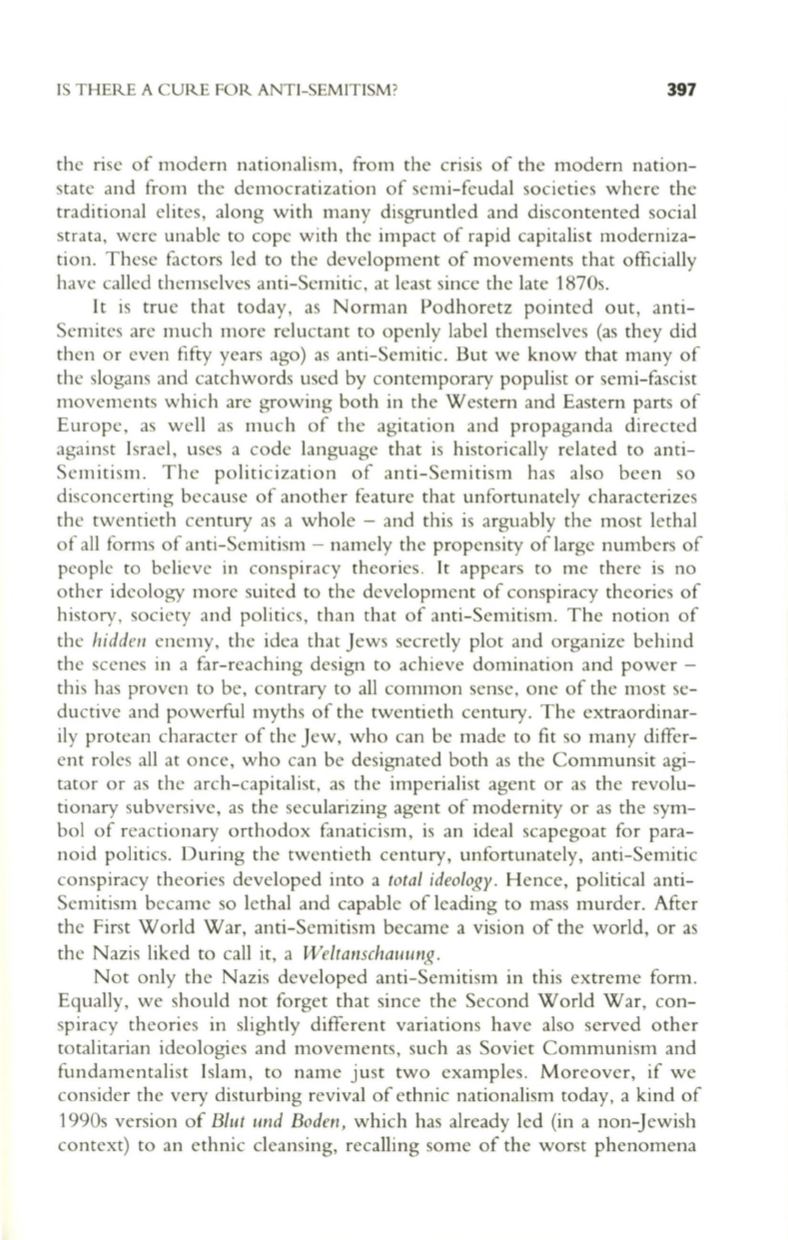
IS THERE A CURE FOR ANTI-SEMITISM;>
397
the rise of modern nationalism, from the crisis of the modern nation–
state and from the democratization of semi-feudal societies where the
traditional elites, along with many disgruntled and discontented social
strata, were una ble to cope with the impact of rapid capitalist moderniza–
tion . These factors led to the development of movements that officially
have called themselves anti-Semitic, at least since the late 1870s.
It is true that today, as Norman Podhoretz pointed out, anti–
Semites are much more reluctant to openly label themselves (as they did
then or even fifty years ago) as anti-Semitic. But we know that many of
the slogans and catchwords used by contemporary populist or semi-fascist
movements which are growing both in the Western and Eastern parts of
Europe, as well as much of the agitation and propaganda directed
against Israel, uses a code language that is historically related to anti–
Semitism. The politicization of anti-Semitism has also been so
disconcerting because of another feature that unfortunately characterizes
the twentieth century as a whole - and this is arguably the most lethal
of all forms of anti-Semitism - namely the propensity of large numbers of
people to believe in conspiracy theories . It appears to me there is no
other ideology more suited to the development of conspiracy theories of
history, society and politics, than that of anti-Semitism. The notion of
the
hidden
enemy, the idea that Jews secretly plot and organize behind
the scenes in a far-reaching design to achieve domination and power -
this has proven to be, contrary to all common sense, one of the most se–
ductive and powerful myths of the twentieth century. The extraordinar–
ily protean character of the Jew, who can be made to fit so many differ–
ent roles all at once, who can be designated both as the Communsit agi–
tator or as the arch-capitalist, as the imperialist agent or as the revolu–
tionary subversive, as the secularizing agent of modernity or as the sym–
bol of reactionary orthodox fanaticism, is an ideal scapegoat for para–
noid politics. During the twentieth century, unfortunately, anti-Semitic
conspiracy theories developed into a
total ideology.
Hence, political anti–
Semitism became so lethal and capable of leading to mass murder. After
the First World War, anti-Semitism became a vision of the world, or as
the Nazis liked to call it, a
Weltanschauung.
Not only the Nazis developed anti-Semitism in this extreme form.
Equally, we should not forget that since the Second World War, con–
sp iracy theories in slightly different variations have also served other
totalitarian ideologies and movements, such as Soviet Communism and
fundamentalist Islam, to name just two examples. Moreover, if we
consider the very disturbing revival of ethnic nationalism today, a kind of
1990s version of
Blut und Boden,
which has already led (in a non-Jewish
context) to an ethnic cleansing, recalling some of the worst phenomena


